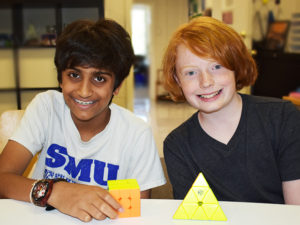By Gigi Ekstrom

When Lakehill’s new Rubik’s Cube Club met for the first time on September 14, it had two avid “Cubers” to thank. “I first saw a kid on a plane solve a Cube and, immediately, I wanted to know more,” said Lakehill seventh grader Vivek Patel (pictured at right, on the left). While he started cubing for fun, Patel now spends 30 minutes a day practicing, and several hours a day on the weekends. His friend, seventh grader Jackson Cook (pictured at right, on the right), has also become a Cube enthusiast. They now spend their time searching websites and watching videos to help them learn different patterns and improve their skills.
The Rubik’s Cube was invented in 1974 by Hungarian professor and architect Erno Rubik. It was immediately popular when it hit shelves worldwide in 1980, quickly becoming the best-selling toy in history. But as the 1980s wore on, the allure of the Rubik’s Cube wore off.
In the early 2000s, however, it began making a comeback. Now a new generation has embraced the puzzle, and the Rubic’s Cube is cool once again.
As cubing has taken off, solve times have dropped. In addition to the classic 3×3 shape, there are 4×4 and 2×2 sizes, and the Pyraminx, a triangle Rubik’s Cube. New “speed cubes” look like Rubik’s Cubes, but have high-tech features, like magnets, on the inside to make turning them smoother and faster. Speed cubing — solving the puzzle quickly — is now a competitive sport. The World Cube Association holds tournaments, with tens of thousands of Cube lovers competing in events around the world. Patel is now taking part in competitions (he’s down to 22 seconds for the 3×3 cube). “It’s really a race against yourself,” he says. “There will always be somebody who is better. The goal is just to improve.”
Both Patel and Cook believe that their cubing is helping to strengthen their minds. “It really helps you focus your brain and improves muscle memory,” says Cook. Sophomore Aron Xiao, who has been cubing as a hobby for three years and started an Upper School club at Lakehill last year, is happy to see more students getting involved. “Cubing is a great way to improve your dexterity and hand-eye coordination, while training your brain to think logically,” he says.
“Using a sequential set of operations to solve a problem gets kids thinking algorithmically,” says Jennifer Herta, Lakehill computer science chair. “That is an important skill in science, math and computer science.”
Delayed gratification may be one of the greatest benefits of the Rubik’s Cube. “You have to have a lot of patience and dedication to be successful,” says Cook. “There are thousands of algorithms. You just have to spend time every day.”
After watching Patel solve a Cube one day, Coach Jhoana Cayme-Mosley offered to sponsor the new club. She says she has always been fascinated by the Rubik’s Cube, and finally learned to solve one 10 years ago. “I watched a YouTube video and spent an entire afternoon learning how to solve it.”
“Our students are cerebral, and they love a challenge,” Cayme-Mosley said. “For them, it’s not just about solving the puzzle; it’s about increasing their speed. It’s a much more sophisticated process. The algorithms even have names. The new cubes are built for speed — no more peeling stickers off to rearrange them like before.”
